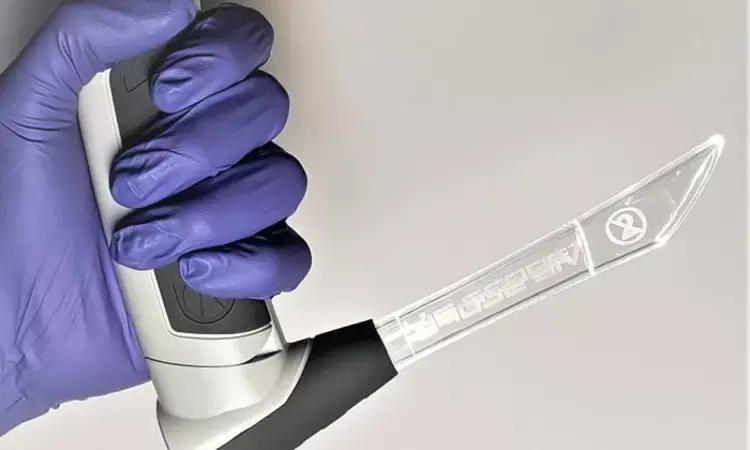- Home
- Medical news & Guidelines
- Anesthesiology
- Cardiology and CTVS
- Critical Care
- Dentistry
- Dermatology
- Diabetes and Endocrinology
- ENT
- Gastroenterology
- Medicine
- Nephrology
- Neurology
- Obstretics-Gynaecology
- Oncology
- Ophthalmology
- Orthopaedics
- Pediatrics-Neonatology
- Psychiatry
- Pulmonology
- Radiology
- Surgery
- Urology
- Laboratory Medicine
- Diet
- Nursing
- Paramedical
- Physiotherapy
- Health news
- Fact Check
- Bone Health Fact Check
- Brain Health Fact Check
- Cancer Related Fact Check
- Child Care Fact Check
- Dental and oral health fact check
- Diabetes and metabolic health fact check
- Diet and Nutrition Fact Check
- Eye and ENT Care Fact Check
- Fitness fact check
- Gut health fact check
- Heart health fact check
- Kidney health fact check
- Medical education fact check
- Men's health fact check
- Respiratory fact check
- Skin and hair care fact check
- Vaccine and Immunization fact check
- Women's health fact check
- AYUSH
- State News
- Andaman and Nicobar Islands
- Andhra Pradesh
- Arunachal Pradesh
- Assam
- Bihar
- Chandigarh
- Chattisgarh
- Dadra and Nagar Haveli
- Daman and Diu
- Delhi
- Goa
- Gujarat
- Haryana
- Himachal Pradesh
- Jammu & Kashmir
- Jharkhand
- Karnataka
- Kerala
- Ladakh
- Lakshadweep
- Madhya Pradesh
- Maharashtra
- Manipur
- Meghalaya
- Mizoram
- Nagaland
- Odisha
- Puducherry
- Punjab
- Rajasthan
- Sikkim
- Tamil Nadu
- Telangana
- Tripura
- Uttar Pradesh
- Uttrakhand
- West Bengal
- Medical Education
- Industry
VieScope a useful option for correct tracheal tube positioning in difficult airways: Study

Intubation with VieScope have similar rates of correct tracheal tube position as the conventional and video laryngoscope, suggests a study published in the BMC Emergency Medicine.
Endotracheal intubation continues to be the gold standard for securing the airway in emergency situations. This is usually achieved by direct laryngoscopy, but is increasingly being supplemented by video laryngoscopy - and in some cases even replaced by it. Difficult intubation due to anatomical conditions or other situational circumstances is a dreadful situation when securing the airway occurring in an estimated 1–6% of the cases.
A group of researchers from Germany conducted a study to compare VieScope with Glidescope and conventional Macintosh laryngoscopy (MAC) in a simulated difficult airway situation.
In this randomized controlled simulation trial, 35 anesthesiologists performed endotracheal intubation using VieScope, GlideScope and MAC in a randomized order on a certified airway manikin with a difficult airway.
The results of the study are as follows:
- For the primary endpoint of the correct tube position, no statistical difference was found.
- Time until intubation for GlideScope and MAC were shorter compared to the VieScope.
- Time to first ventilation, GlideScope and MAC were also shorter compared to the VieScope.
- There was no difference was shown between handling time for VieScope and time until intubation with GlideScope or MAC.
- Participants stated a better Cormack & Lehane Score with VieScope, compared to direct laryngoscopy.
Thus, the researchers concluded that the rate of correct tracheal tube position was comparable between the three devices. Time to intubation and ventilation was shorter with conventional Macintosh laryngoscopy (MAC) and Glidescope compared to VieScope. It did however show a comparable handling time to video laryngoscopy and conventional Macintosh laryngoscopy (MAC). It also did show a better visualization of the airway in the Cormack & Lehane Score compared to conventional Macintosh laryngoscopy (MAC).
Reference:
Comparison of the novel VieScope with conventional and video laryngoscope in a difficult airway scenario – a randomized, controlled simulation trial by Ecker H et. al published in the BMC Emergency Medicine.
DOI: https://doi.org/10.1186/s12873-021-00484-6
Dr. Shravani Dali has completed her BDS from Pravara institute of medical sciences, loni. Following which she extensively worked in the healthcare sector for 2+ years. She has been actively involved in writing blogs in field of health and wellness. Currently she is pursuing her Masters of public health-health administration from Tata institute of social sciences. She can be contacted at editorial@medicaldialogues.in.
Dr Kamal Kant Kohli-MBBS, DTCD- a chest specialist with more than 30 years of practice and a flair for writing clinical articles, Dr Kamal Kant Kohli joined Medical Dialogues as a Chief Editor of Medical News. Besides writing articles, as an editor, he proofreads and verifies all the medical content published on Medical Dialogues including those coming from journals, studies,medical conferences,guidelines etc. Email: drkohli@medicaldialogues.in. Contact no. 011-43720751


